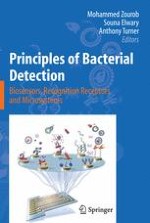2008 | OriginalPaper | Buchkapitel
Phage Display Methods for Detection of Bacterial Pathogens
verfasst von : Paul A. Gulig, Julio L. Martin, Harald G. Messer, Beverly L. Deffense, Crystal J. Harpley
Erschienen in: Principles of Bacterial Detection: Biosensors, Recognition Receptors and Microsystems
Verlag: Springer New York
Aktivieren Sie unsere intelligente Suche, um passende Fachinhalte oder Patente zu finden.
Wählen Sie Textabschnitte aus um mit Künstlicher Intelligenz passenden Patente zu finden. powered by
Markieren Sie Textabschnitte, um KI-gestützt weitere passende Inhalte zu finden. powered by
There exists a great need for detecting bacterial pathogens in food, water, environmental, and patient samples. Although significant developments are being made in nucleic acid-based detection, e.g., real time-PCR, there are advantages to detecting microbial antigens using a variety of assays such as enzyme-linked immunosorbent assay (ELISA), antibody arrays, fiber optics, and surface plasmon resonance. Immunological reagents used to detect microbial antigens have mostly consisted of antisera or monoclonal antibodies. However, over the past two decades new methods have been developed that use bacteriophages (phages), viruses of bacteria, as tools to express antibody fragments or random peptides that can detect microbes. The most widely used antibody fragment is the single chain F variable (scFv) portion that includes the antigen-binding regions of the heavy and light chains. The genes encoding antibodies can be obtained either from unimmunized animals or from animals immunized with the target antigen or microbe. scFv libraries are usually constructed in specialized plasmids called phagemids that create fusions of the antibody fragment to a phage coat protein. Phagemids must be packaged into phage particles by the use of helper phages during infection of
E. coli
hosts. Random peptides are usually constructed in phage genomes directly; hence, they do not require helper phages. DNA sequences encoding random peptides and antibodies are most often fused to the
gIII
gene of a filamentous phage such as M13 so that a hybrid pIII protein is expressed on the phage particle. Phage particles that display a fusion peptide that recognizes the desired antigen are selected from the library by a process called panning. Panning involves binding phages to the antigen, washing away unbound phages, eluting the specific phages, and amplification by infection of an
E. coli
host. A major advantage of phage display is that panning and screening of clones can be accomplished in only a few days, as opposed to months for antisera and monoclonal antibodies. Once a phage displaying an antibody fragment or random peptide of desired specificity is isolated, the gene encoding the binding peptide can be genetically manipulated. With scFvs, it is possible to have
E. coli
cells secrete the protein, rather than relying on the use of the phage particle displaying the scFv protein. This chapter reviews the literature on the use of phage display to detect bacteria in a variety of assays. There has been considerable success in the use of commercially available random peptide phage display libraries. Most reported success with scFv phage display has been from using libraries constructed from immunized animals. In addition to antibodies, other target-binding tools are under development, such as affibodies, anticalins, ankyrins, and trinectins. The ease, economy, rapidity, and genetic manipulability of phage display make it an effective tool for developing reagents to detect bacterial pathogens.
